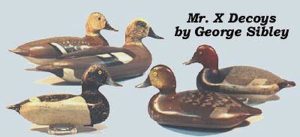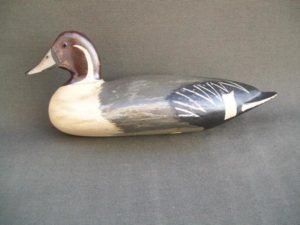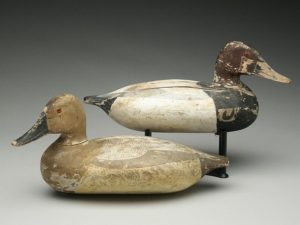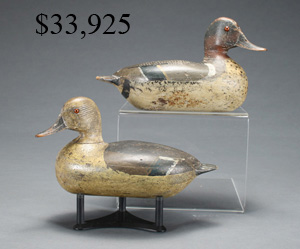A Decoy Corner Article
By Bruce Urben, President
The Sibley Decoy company was owned by father and son, James A. and George M. Sibley, of Chicago, Illinois. The Sibley Company began producing decoys in 1899 and, according to history, the Sibley family was part of the old guard American families that traces its roots back to 1629 in the New England colonies. James A. Sibley provided the financial backing to his son George for the decoy company. George was an avid waterfowler and one of the original members of the prestigious Hennepin Shooting Club on the Illinois river. George lived and worked in Chicago prior to his move in setting up his decoy factory in Whitehall, Michigan. Whitehall is located in central lower Michigan on White Lake, adjacent to Lake Michigan. Seems his cousin had a large lumber mill there and supplied all of his decoy lumber.
Sibley decoys were produced on a production line much like Mason decoys. The decoy parts were turned on a lathe, assembled, hand finished and painted. The uniqueness of the Sibley Decoy is in its hardwood inserted bill that is mitered into the head. This process was used to reduce bill breakage during use. The insert joints on the head are clearly visible on all Sibley decoys. According to their sales flyer, Sibley produced canvasbacks, redhead, bluebill, ringbill, pintail, widgeon, blue wing and green wing teal decoys. They were sold by the dozen, 1/2 male and 1/2 female for $12.00. The decoys had finely carved heads with taxidermist-quality glass eyes. Most bodies were hollowed by machine and a strip of strap steel was inserted inside the body for ballast. A small leather strap was fixed to the bottom for an anchor line. The paint pattern on Sibleys was very simple, with no blending. The backs of the drakes were vermiculated and set with bold, painted wing patches. Hen’s backs were crudely feathered with the same wing patches. All of the bottoms were coated with a thick layer of white lead paint and “patent applied for” was stamped in ink. There was however, no record of a patent ever being applied for, or issued, to Sibley! Some of the decoys were factory stamped with an “L” in the middle of a diamond, but for reasons unknown.
 Collectors for many years were not able to identify the carver of the inletted bill decoys and just called them Mr. X decoys. Thanks is due to a collector in Illinois who came across an old Sibley advertising flyer who was able to clearly identify George Sibley as the carver.
Collectors for many years were not able to identify the carver of the inletted bill decoys and just called them Mr. X decoys. Thanks is due to a collector in Illinois who came across an old Sibley advertising flyer who was able to clearly identify George Sibley as the carver.
It is unknown how long Sibley produced decoys and, as you would expect, because of the unique bill design, they are highly sought after by collectors. Decoy values appear to be high for any Sibley decoy, even those in poor condition, unless the bill insert is badly damaged or repaired. Low end values are near $1,000 and examples of less produced species in excellent condition can be valued in the tens of thousands of dollars. If you come across a decoy with an inletted bill, chances are it may be a Sibley. But, as always, consult with a reputable collector or dealer to confirm carver and condition.
If you have a Sibley, enjoy a classic piece of floating art that was made over 120 years ago.



